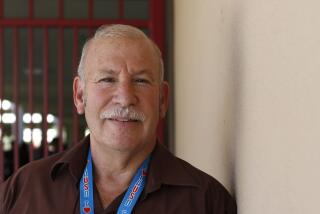A Day for Second Chances
FOUR-PART SERIES: The Times examines why so many students drastically limit their prospects by dropping out of high school.
As the sun slipped behind the clouds, Isaac Castillo pulled his black-tinted shades over his eyes and stepped into a rainbow of caps and gowns. Chest puffed out and royal blue tassel swinging, he strutted past exuberant spectators holding teddy bears and bouquets of balloons.
A year ago, Isaac, then 18, cried as he watched what should have been his Birmingham High School graduation ceremony from behind a chain-link fence.
FOR THE RECORD:
Graduation: A story in Friday’s California section about a continuation school graduation attributed a quote about overcoming drug addiction to the wrong speaker. The story stated that Barbara Hernandez from Youth Opportunities Unlimited High School, said: “My story is just one of the hundreds of stories seated in these chairs this afternoon. We have worked incredibly hard to make up for past mistakes.” That quote actually came from Amy Leckliter of Mt. Lukens High School. —
On Thursday, his friends and family waited to hear “Isaac Castillo” ring from the speakers in a little-known graduation ceremony held on the gang-neutral territory of Pacific Palisades. Isaac was among nearly 800 students from across Los Angeles who graduated from one of the Los Angeles Unified School District’s 59 alternative high schools this year.
“I never thought this day would come,” said Isaac, who donned a white cap and gown in the ceremony on the football field named the Stadium by the Sea at Pacific Palisades Charter High School.
Isaac belongs to a group of 11 childhood buddies — they call themselves the Outsiders — featured in a February Los Angeles Times series on high school dropouts. In 2001, they entered high school in Van Nuys together. At Birmingham, they fought, skipped, stumbled and failed together.
Only three Outsiders from Birmingham’s class of 2005 graduated. Isaac was among the eight who didn’t make it.
Eight months later, he became one of 8,000 students enrolled in L.A. Unified’s Educational Options programs. Each year, more than 1,000 students earn diplomas from the alternative schools, according to Ken Easum, district coordinator for the department.
Yet as Mayor Antonio Villaraigosa uses the district’s high dropout rate to bolster his school takeover plan, and the district carves its large campuses into clusters of smaller learning academies, Easum feels like the kid in the back of the classroom who can’t get the teacher’s attention.
“We’re the model they ignore,” said Easum, who added that neither the mayor nor Supt. Roy Romer has attended an Options graduation.
“We’re one of the largest dropout prevention programs in the state — and the dropout numbers reflect that,” Easum said. “Our job is to help these kids after other schools have given up on them.”
This year’s ceremony suggested that the district might finally be catching on. It drew top-level administrators as well as Board of Education President Marlene Canter, who gave a keynote address.
“You are the ones the dropout statistics missed, and you are the ones who never gave up,” Canter told the students, who wore white, blue, black, green, gray and burgundy gowns, depending on which school they had attended.
A study of graduation rates released this week by Education Week researchers concluded that less than half of L.A. Unified students graduate from high school within four years — a number that district and state officials dispute.
Alternative schools have been largely left out of recent discussions about boosting graduation rates. Most districts would rather focus on improving existing high schools than on expanding the alternatives, which tend to cost more, said Dennis Fisher, consultant to the state Department of Education on continuation schools.
“The very existence of Options,” he said, suggests that the traditional program “isn’t perfect.”
Thursday’s ceremony celebrated a rite of passage that the graduates might otherwise have missed. Their families traveled from across the city to the upscale beach community that organizers chose for the ceremony because it did not cross gang turfs.
“We have people coming from all over the county — Bloods, Crips,” said Robert Meier, an Options assistant principal.
Against a backdrop of green hills and an American flag, one student speaker wept as she talked about overcoming drug addiction. She said she found support at Youth Opportunities Unlimited High School.
“My story is just one of the hundreds of stories seated in these chairs this afternoon,” said Barbara Hernandez. “We have worked incredibly hard to make up for past mistakes.”
Isaac listened, knowing he too had made mistakes. As one of 4,000 students enrolled at Birmingham in 2001, he found that teachers and counselors hardly noticed when he started cutting class with friends.
His problems at school swelled as he got into race-related feuds and struggled in subjects such as geometry and history. During his junior year, a gang member held a gun to his head on campus. With too few credits to graduate, Isaac dropped out in May 2005, just weeks before graduation.
After reading the Times series, Cynthia Gladstone, principal of the 115-student Independence Continuation High School across the street from Birmingham, decided to give Isaac and three of his friends another shot despite a waiting list of 30 students.
In February, Gladstone asked one of her students — an Outsider named Andy Hurtarte who had dropped out of Birmingham in 2004 — to round up his friends and bring them to her office. A few days later, Isaac enrolled in the small campus housed in three beige bungalows, along with the other Outsiders.
They attended classes at Independence four hours a day, working at their own pace. With about 20 youths in each class, teachers offered one-on-one guidance. The students signed in to school, and signed out. When they missed class, a secretary called their parents.
But the tug of past habits haunted them. The other three boys soon dropped out to work.
Their decisions didn’t startle Gladstone. In her 22 years as principal at Independence, she has seen students change their minds two, three, sometimes four times before they actually buckle down and finish. When they’re ready, she is there.
“School is a habit,” Gladstone said. “When they get out of the habit, it’s hard to go back.”
Isaac finished his last four classes in four months at Independence. But when his friends dropped out, he had started sleeping late and missing classes, and his mother soon came to recognize the Independence secretary’s voice. After a few sluggish weeks and a lot of cajoling from his mother, Isaac arrived back at school ready to make a final push.
“I was so close,” he said. “I didn’t want to throw it all away.”
This year, 30 students earned diplomas from Independence — its largest graduating class.
Like seniors across the state, Options students were required to pass the California High School Exit Exam. District officials estimated that alternative school students passed at a slightly lower percentage than the district’s overall rate of 86%.
Because Isaac has a learning disability, he was eligible for an exit exam waiver requiring that he take the test but not that he pass it. He passed the English portion, but failed math. Under waiver rules he must take the test again before Gladstone can actually give him his diploma. After making it this far, Isaac promised her that he would follow through.
In the stands Thursday, Isaac’s mother, Julie Castillo, rubbed her arms, warming them against the sea breeze.
“I’m glad he made it here,” she said. “It was a long journey for him. I want him to keep going.”
With that, the sun emerged from behind the clouds, shining gloriously.
Isaac stood and followed a stream of colors to the front of the field.
“Isaac Castillo,” Gladstone announced.
His mother popped out of her seat and cheered.
Times staff writers Nancy Cleeland and Joel Rubin contributed to this report.
More to Read
Start your day right
Sign up for Essential California for news, features and recommendations from the L.A. Times and beyond in your inbox six days a week.
You may occasionally receive promotional content from the Los Angeles Times.






